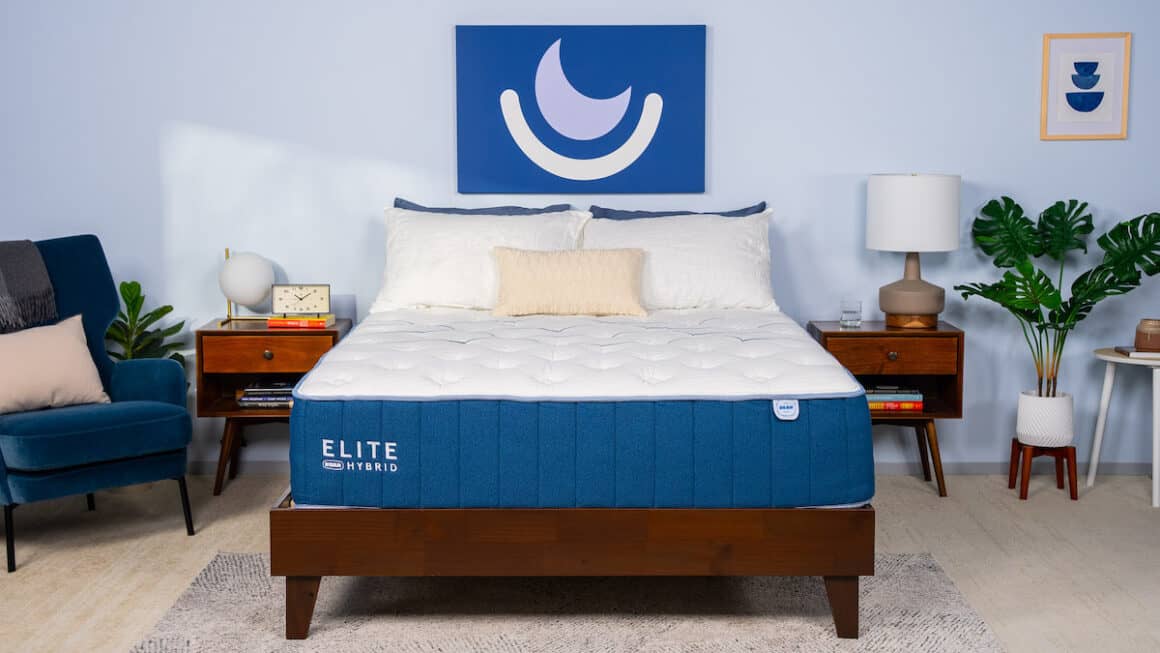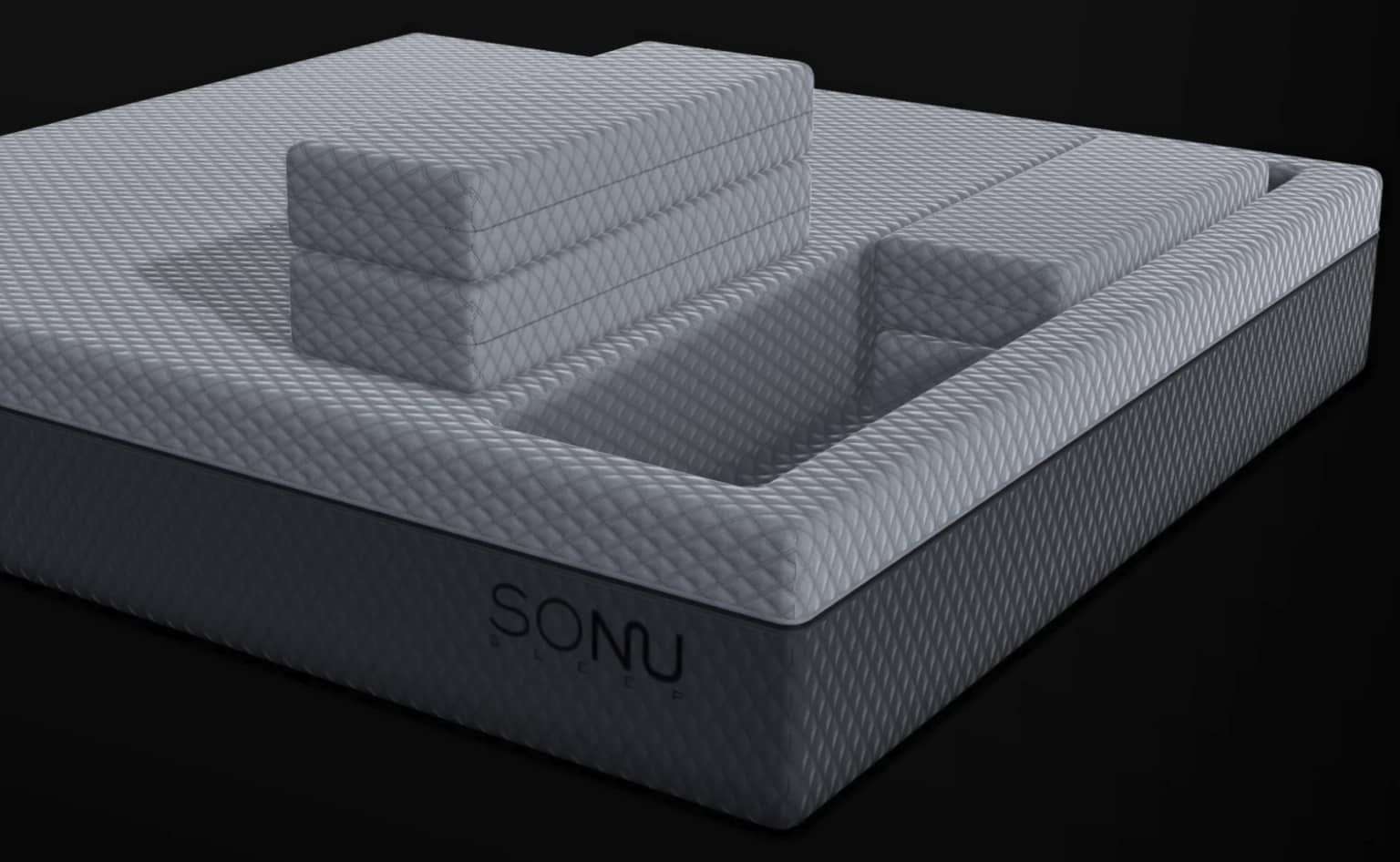On This Page
The Best Mattress for Side Sleepers
Our Top Picks
-
Best Mattress Overall
Helix Midnight Luxe -
Most Comfortable Mattress
Nolah Evolution 15 -
Best Mattress for Pressure Relief
WinkBed -
Best Mattress for Hip Pain
Bear Elite Hybrid -
Best Value Mattress
Eco Terra Hybrid Latex Mattress -
Best Mattress Firmness Options
DLX Premier Hybrid -
Best Mattress for Couples
Leesa Sapira Hybrid -
Best Luxury Mattress
Sonu Sleep System -
Best Mattress for Back Pain
Brooklyn Bedding Signature Hybrid
Best Mattress Overall

Created with side sleepers in mind, the Helix Midnight Luxe checks all of the important boxes for people who primarily use this position. Plush foams cushion the shoulders and hips, while sturdy zoned pocketed coils prevent your body from sinking too deeply into the mattress.
Pros & Cons
Pros
- Adaptive foams create a cushy, pressure-relieving surface
- Reinforced perimeter coils reduce sinkage along the edges
- Targeted support for the torso and hips
Cons
- Stomach sleepers over 230 pounds may not receive enough support
- Foam layers emit strong off-gassing smells for the first few nights
Ratings
Our Take
Most Comfortable Mattress
The Nolah Evolution 15 combines a thick comfort system with robust, multi-zone coils. The result is a hybrid that nicely balances cushioning, support, and bounce, and you can choose between three firmness levels to further optimize your sleep surface.
Pros & Cons
Pros
- Deep foam layers offer next-level cushioning and weight distribution
- Three firmness levels to accommodate side sleepers in different weight groups
- Coils are zoned to deliver extra support beneath your midsection
Cons
- High potential for strong initial off-gassing
- All returns incur a $99 fee
Ratings
Our Take
Best Mattress for Pressure Relief
Side sleepers are susceptible to pressure buildup in their shoulders and hips, so a mattress that alleviates these sore spots is a top priority for many. The WinkBed is a safe bet because you can choose from four firmness levels — and if you don’t like your first choice, you can exchange it for a softer or firmer model at no extra charge.
Pros & Cons
Pros
- Zoned coils and foam comfort layers excel at pressure relief for side sleepers
- Cover made with breathable, moisture-wicking Tencel fabric
- Available in four firmness levels
Cons
- Limited options for those who prefer exceptionally soft mattresses
- The soft firmness option can be a bit difficult to move around on
Ratings
Our Take
Best Mattress for Hip Pain

With a contouring memory foam surface, zoned support layers, and three firmness options, the Bear Elite Hybrid seems tailor-made for side sleeping. The extra reinforcement beneath the torso and hips can be a game-changer if you experience pain or pressure points with this sleep position.
Pros & Cons
Pros
- Memory foam creates a cushy, adaptive surface that cushions sore spots
- Multi-zone transitional and coil layers deliver extra support where it’s needed
- Available in three firmness levels
Cons
- Initial off-gassing odor can be overpowering
- Those seeking an exceptionally soft mattress may not be satisfied with any of the firmness options
Ratings
Our Take
Best Value Mattress

Available in two firmness levels to accommodate side sleepers in different weight groups, the Eco Terra uses responsive organic latex and zoned coils to maintain an even sleep surface. This design ensures optimal alignment and fewer pressure points along the spine.
Pros & Cons
Pros
- Zoned coils and Talalay latex distribute weight evenly
- Breathable wool, latex, cotton, and coils help regulate temperature
- Available in two firmness levels
Cons
- Latex lacks the close contouring of foam
- Bouncy surface transfers some motion
- Provides less pressure relief than some hybrids
Ratings
Our Take
Best Mattress Firmness Options

Nailing down your ideal firmness is key to getting a good night’s sleep, and some mattresses don’t give you many options. The DLX Premier Hybrid lets you choose from three firmness levels ranging from medium soft to firm, as well as a split design with a different feel on each half of the bed.
Pros & Cons
Pros
- Adaptive foam excels at pressure relief for side sleepers
- Available in four firmness levels, including a dual-firmness option
- Strong edge support due to reinforced perimeter coils
Cons
- Soft option lacks strong edge support
- Firm feel not available in dual-firmness option
Ratings
Our Take
Best Mattress for Couples

Thanks to its balanced feel, the Leesa Sapira Hybrid is Goldilocks mattress option for side sleepers seeking a close contour, sturdy support, and a light bounce in response to movement. Open-cell foams and steady internal airflow also help ensure this mattress sleeps at a comfortable temperature.
Pros & Cons
Pros
- Adaptive foams provide deep cushioning for the shoulders and hips
- Reinforced perimeter coils deliver sturdy edge support
Cons
- Adaptive foams provide deep cushioning for the shoulders and hips
- Reinforced perimeter coils deliver sturdy edge support
Ratings
Our Take
Best Luxury Mattress

The Sonu Mattress has a channeled design specifically intended to help side sleepers rest comfortably without experiencing pressure buildup in their shoulders. The softer feel and all-foam design are particularly well suited to side sleepers under 130 pounds.
Pros & Cons
Pros
- Built-in space for the shoulders and arms specially designed for side sleepers
- Available in three firmness levels
Cons
- Built-in space for the shoulders and arms specially designed for side sleepers
- Available in three firmness levels
Ratings
Our Take
Best Mattress for Back Pain

Side sleepers with back pain should be satisfied with the Brooklyn Bedding Signature, a foam hybrid that delivers exceptional balance with gently contouring comfort layers and a sturdy coil system. You can choose from three firmness options based on your weight and how much support you need.
Pros & Cons
Pros
- Adaptive foam layers cushion the body without hugging too closely
- Available in three firmness levels to accommodate different body types
- Optional pillow-top adds extra plushness and cooling to the surface
Cons
- Strong off-gassing smell may persist for up to 72 hours after unboxing
- Firmness exchanges are not available during the trial period
Ratings
Our Take
Compare Our Top Picks
| Mattress | Mattress Type | Ideal For | Value | Sleep Trial |
| Helix Midnight Luxe | Hybrid | Combination Sleepers | Good Value | 100 nights (30-night requirement) |
| Nolah Evolution 15 | Hybrid | Most Sleepers | Good Value | 120 nights (30-night requirement) |
| WinkBed | Innerspring | Side Sleepers | Good Value | 120 nights (30 night requirement) |
| Bear Elite Hybrid | Hybrid | People With Back Pain | Good Value | 120 nights (30-night break-in period) |
| Eco Terra Hybrid Latex Mattress | Hybrid | Back sleepers | Great Value | 90 nights (30-night requirement) |
| DLX Premier Hybrid | Hybrid | Couples | Fair Value | 120 nights (30-night requirement) |
| Leesa Sapira Hybrid | Hybrid | Side Sleepers | Good Value | 100 nights (30 night requirement) |
| Sonu Sleep System | Foam | Side Sleepers | Fair Value | 100 nights (60-night requirement) |
| Brooklyn Bedding Signature Hybrid | Hybrid | Couples | Great Value | 120 nights (30-night requirement) |
What Kind of Support Do Side Sleepers Need From Their Bed?
Support refers to how well a mattress promotes spinal alignment. To this end, the mattress should offer the right combination of firmness and contouring. For side sleepers, the mattress should offer cushion and pressure relief at the hips and shoulders, but also enough support to keep these areas from sinking too much. The mattress that offers the best support will vary depending on your weight and body type.
Side sleepers put more pressure on their hips and shoulders, which can cause real issues over time if their mattress is too firm – or so old it is no longer supportive. Look for a mattress on the soft to medium-firm side that offers contouring while also providing support.
What Should Side Sleepers Consider in a Mattress?
When shopping for a mattress, side sleepers should consider a number of factors in relation to their personal needs, preferences, and body type.
Mattress Type
The most common mattress designs are foam, innerspring, hybrid, latex, and airbeds. Each uses different materials which affect performance for side sleepers.
In all-foam mattresses, one or more comfort layers of memory foam or polyfoam rest above a core of high-density polyfoam. Foam mattresses normally excel at contouring, motion isolation, and pressure relief.
Hybrid mattresses combine comfort layers of foam or other materials with a support core of pocketed coils. The design aims to balance cushioning comfort layers with a more responsive support core. While the comfort system contours to relieve pressure, the coils add bounce, responsiveness, and breathability.
Traditional innerspring mattresses, which consist solely of a spring core and a cover, are less common these days. This design lacks the pressure relief that side sleepers need for proper spinal alignment. However, some manufacturers now use the terms innerspring and hybrid interchangeably. If you’re considering a hybrid or innerspring bed, we recommend choosing a model with enough contouring to support the spine and prevent pressure buildup.
Latex mattresses are constructed from either Dunlop or Talalay latex, both of which provide a surprisingly responsive surface. While latex doesn’t conform to the body like foam, it still offers a moderate amount of cushion. Since the material also springs back quickly when the sleeper moves, our testers often give latex mattresses exceptional marks in ease of movement. Additionally, latex’s open-cell structure increases airflow to promote cooler sleep.
Mattress Firmness
We rate mattresses on a 10-point firmness scale, with 1 being the softest and 10 the firmest.
In general, side sleepers tend to prefer mattresses that fall somewhere in the middle, between 4 (medium soft) and 7 (medium firm). They need a mattress that is responsive enough to prevent sinking, but which gives them extra cushion at the hips and shoulders.
Your ideal mattress firmness will vary according to your weight. In general, heavier sleepers will need a firmer mattress for proper spinal alignment.
Pressure Relief
Mattresses that provide pressure relief help lessen tension and impact at key points of the body. By doing so, they help keep the spine straight to prevent aches and pains. Side sleepers should choose a mattress that delivers pressure relief at their hips and shoulders.
Contouring
Contouring refers to how closely the mattress conforms to, or hugs, the sleeper’s body. For side sleepers, a mattress that cradles the body can help relieve pressure and further promote spinal alignment. Mattresses with contouring properties are especially helpful for side sleepers who experience aches and pains.
Breathability
Breathability relates to how well a mattress regulates temperature. Mattresses made from breathable materials such as cotton, latex, and coiled springs allow more air to circulate, which prevents heat retention.
On the other hand, foam traps heat. Many manufacturers infuse their foam layers with cooling gel or use covers that wick heat and moisture to counter this tendency.
Helpful Tips for Keeping Your Spine Aligned as a Side Sleeper
Besides choosing the right mattress, there are other simple steps that side sleepers can take to promote spinal alignment.
Use a Pillow With the Right Loft
A pillow’s loft refers to its height and thickness. Because it determines how much your head is elevated in relation to the rest of your body, loft can affect spinal alignment.
Side sleepers need a thicker pillow than most to maintain a straight spine. The best pillows for side sleepers generally have a medium to high loft that sufficiently cushions the head and neck without excess sinking.
Practice Healthy Sleep Posture
Maintaining proper posture while sleeping can go a long way in preventing spine alignment problems. For side sleepers, the pillow should rest between their ear and the bed. The top leg should be close to even with the bottom leg. Bending the knees slightly upward can reduce strain on the back.
Tuck a Pillow Between Your Knees
Side sleepers will benefit from tucking a pillow between their knees while they sleep. Elevating the top leg this way helps align it with the hips, pelvis, and spine. While any pillow works for this method, specialty knee pillows are also available.
Discover More Mattress Solutions
If you’re looking for a particular type of bed, like one with memory foam or latex, check out our more specific guides below.
More Mattress Options
How We Test
Our seasoned testing team assessed dozens of leading mattresses to identify the best options for side sleepers. We evaluated key factors like pressure relief, spinal alignment, and responsiveness across various mattress types and price ranges. Our testers span a range of body types and weights to ensure that our data is relevant for all types of sleepers. We continuously update our top mattress picks so side sleepers have current recommendations. Wondering what other side sleepers like you choose as their new mattress? Check out the best mattresses for side sleepers, as chosen by our customers.
Frequently Asked Questions
You should replace your mattress when it begins to negatively impact your sleep, generally every six to eight years. Mattress durability varies according to quality and type of materials used, as well as maintenance and care. For example, foam varies widely in quality and durability, while latex can often last well beyond eight years.
Mattresses that range between medium soft and medium firm are generally best for side sleepers, who need a mattress that’s soft enough to cushion their pressure points, but firm enough to prevent excess sinking. That said, the ideal mattress firmness varies based on your body weight.
Side sleepers with hip and shoulder pain should choose a mattress that offers pressure relief and cushion in the painful areas without excess sinking. A mattress with contouring that cradles the body can further alleviate body aches. Memory foam is a great material to look for in a mattress if pressure relief is your top concern.
The best mattress for side sleepers with back pain should promote spinal alignment by providing a balance of firmness and cushion. The ideal balance of these properties varies according to your body weight, with heavier sleepers usually requiring a firmer mattress.
The healthiest sleeping position varies according to your body type and specific needs, but it should promote healthy posture and prevent pain. While all sleep positions have benefits and drawbacks, most adults prefer to sleep on their side. Back sleeping may help avoid skin irritation from your pillow and sometimes helps with lower back pain. Stomach sleeping causes more strain on the body, and requires sleepers to expend more energy breathing.
